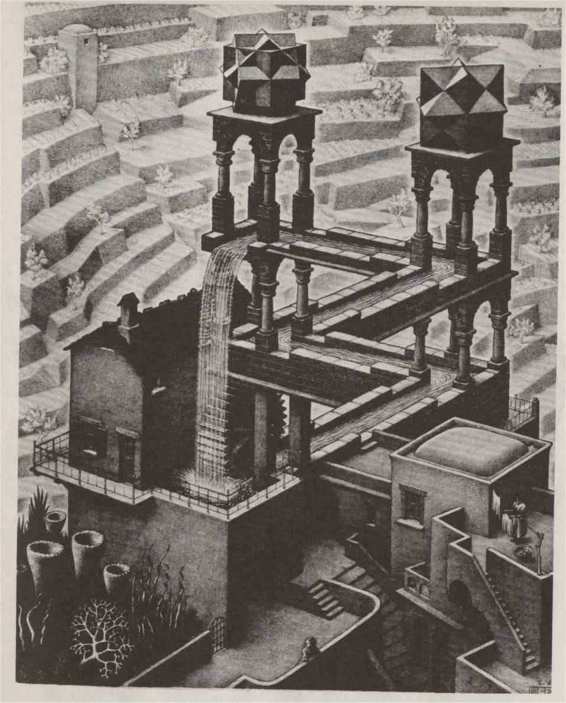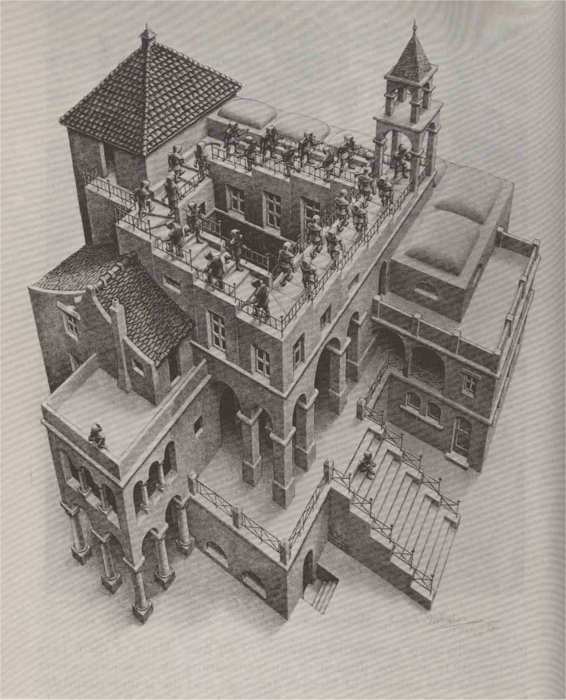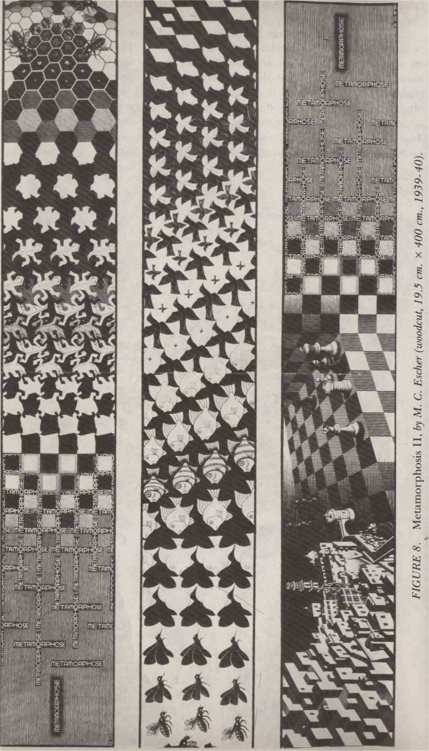Gödel, Escher, Bach: An Eternal Golden Braid (4 page)
Read Gödel, Escher, Bach: An Eternal Golden Braid Online
Authors: Douglas R. Hofstadter
Tags: #Computers, #Art, #Classical, #Symmetry, #Bach; Johann Sebastian, #Individual Artists, #Science, #Science & Technology, #Philosophy, #General, #Metamathematics, #Intelligence (AI) & Semantics, #G'odel; Kurt, #Music, #Logic, #Biography & Autobiography, #Mathematics, #Genres & Styles, #Artificial Intelligence, #Escher; M. C

We are not yet done! The next stage of complexity in canon construction is to invert the theme, which means to make a melody which jumps down wherever the original theme jumps up, and by exactly the same number of semitones. This is a rather weird melodic transformation, but when one has heard many themes inverted, it begins to seem quite natural. Bach was especially fond of inversions, and they show up often in his work-and the Musical Offering is no exception. (For a simple example of
inversion, try the tune "Good King Wenceslas". When the original and its inversion are sung together, starting an octave apart and staggered with a time-delay of two beats, a pleasing canon results.) Finally, the most esoteric of "copies" is the retrograde copy-where the theme is played backwards in time. A canon which uses this trick is affectionately known as a crab canon, because of the peculiarities of crab locomotion.
Bach included a crab canon in the Musical Offering, needless to say. Notice that every type of "copy" preserves all the information in the original theme, in the sense that the theme is fully recoverable from any of the copies. Such an information preserving transformation is often called an isomorphism, and we will have much traffic with isomorphisms in this book.
Sometimes it is desirable to relax the tightness of the canon form. One way is to allow slight departures from perfect copying, for the sake of more fluid harmony. Also, some canons have "free" voices-voices which do not employ the canon's theme, but which simply harmonize agreeably with the voices that are in canon with each other.
Each of the canons in the Musical Offering has for its theme a different variant of the King's Theme, and all the devices described above for making canons intricate are exploited to the hilt; in fact, they are occasionally combined. Thus, one three-voice canon is labeled "Canon per Augmentationem, contrario Motu"; its middle voice is free (in fact, it sings the Royal Theme), while the other two dance canonically above and below it, using the devices of augmentation and inversion. Another bears simply the cryptic label
"Quaerendo invenietis" ("By seeking, you will discover"). All of the canon puzzles have been solved. The canonical solutions were given by one of Bach's pupils, Johann Philipp Kirnberger. But one might still wonder whether there are more solutions to seek!
I should also explain briefly what a fugue is. A fugue is like a canon, in that it is usually based on one theme which gets played in different voices and different keys, and occasionally at different speeds or upside down or backwards. However, the notion of fugue is much less rigid than that of canon, and consequently it allows for more emotional and artistic expression. The telltale sign of a fugue is the way it begins: with a single voice singing its theme. When it is done, then a second voice enters, either five scale-notes up, or four down. Meanwhile the first voice goes on, singing the
"countersubject": a secondary theme, chosen to provide rhythmic, harmonic, and melodic contrasts to the subject. Each of the voices enters in turn, singing the theme, often to the accompaniment of the countersubject in some other voice, with the remaining voices doing whatever fanciful things entered the composer's mind. When all the voices have
"arrived", then there are no rules. There are, to be sure, standard kinds of things to do-but not so standard that one can merely compose a fugue by formula. The two fugues in the Musical Offering are outstanding examples of fugues that could never have been
"composed by formula". There is something much deeper in them than mere fugality.
All in all, the Musical Offering represents one of Bach's supreme accomplishments in counterpoint. It is itself one large intellectual fugue, in
which many ideas and forms have been woven together, and in which playful double meanings and subtle allusions are commonplace. And it is a very beautiful creation of the human intellect which we can appreciate forever. (The entire work is wonderfully described in the book f. S. Bach's Musical Offering, by H. T. David.)
An Endlessly Rising Canon
There is one canon in the Musical Offering which is particularly unusual. Labeled simply
"Canon per Tonos", it has three voices. The uppermost voice sings a variant of the Royal Theme, while underneath it, two voices provide a canonic harmonization based on a second theme. The lower of this pair sings its theme in C minor (which is the key of the canon as a whole), and the upper of the pair sings the same theme displaced upwards in pitch by an interval of a fifth. What makes this canon different from any other, however, is that when it concludes-or, rather, seems to conclude-it is no longer in the key of C
minor, but now is in D minor. Somehow Bach has contrived to modulate (change keys) right under the listener's nose. And it is so constructed that this "ending" ties smoothly onto the beginning again; thus one can repeat the process and return in the key of E, only to join again to the beginning. These successive modulations lead the ear to increasingly remote provinces of tonality, so that after several of them, one would expect to be hopelessly far away from the starting key. And yet magically, after exactly six such modulations, the original key of C minor has been restored! All the voices are exactly one octave higher than they were at the beginning, and here the piece may be broken off in a musically agreeable way. Such, one imagines, was Bach's intention; but Bach indubitably also relished the implication that this process could go on ad infinitum, which is perhaps why he wrote in the margin "As the modulation rises, so may the King's Glory." To emphasize its potentially infinite aspect, I like to call this the "Endlessly Rising Canon".
In this canon, Bach has given us our first example of the notion of Strange Loops. The
"Strange Loop" phenomenon occurs whenever, by moving upwards (or downwards) through the levels of some hierarchical system, we unexpectedly find ourselves right back where we started. (Here, the system is that of musical keys.) Sometimes I use the term Tangled Hierarchy to describe a system in which a Strange Loop occurs. As we go on, the theme of Strange Loops will recur again and again. Sometimes it will be hidden, other times it will be out in the open; sometimes it will be right side up, other times it will be upside down, or backwards. "Quaerendo invenietis" is my advice to the reader.
Escher
To my mind, the most beautiful and powerful visual realizations of this notion of Strange Loops exist in the work of the Dutch graphic artist M. C. Escher, who lived from 1902 to 1972. Escher was the creator of some of the

FIGURE 5. Waterfall, by M. C. Escher (lithograph, 1961).
most intellectually stimulating drawings of all time. Many of them have their origin in paradox, illusion, or double-meaning. Mathematicians were among the first admirers of Escher's drawings, and this is understandable because they often are based on mathematical principles of symmetry or pattern ... But there is much more to a typical Escher drawing than just symmetry or pattern; there is often an underlying idea, realized in artistic form. And in particular, the Strange Loop is one of the most recurrent themes in Escher's work. Look, for example, at the lithograph Waterfall (Fig. 5), and compare its six-step endlessly falling loop with the six-step endlessly rising loop of the "Canon per Tonos". The similarity of vision is

FIGURE 6. Ascending and Descending, by M. C. Escher (lithograph, 1960).

remarkable. Bach and Escher are playing one single theme in two different "keys": music and art.
Escher realized Strange Loops in several different ways, and they can be arranged according to the tightness of the loop. The lithograph Ascending and Descending (Fig. 6), in which monks trudge forever in loops, is the loosest version, since it involves so many steps before the starting point is regained. A tighter loop is contained in Waterfall, which, as we already observed, involves only six discrete steps. You may be thinking that there is some ambiguity in the notion of a single "step"-for instance, couldn't Ascending and Descending be seen just as easily as having four levels (staircases) as forty-five levels (stairs)% It is indeed true that there is an inherent
FIGURE 7. Hand with Reflecting Globe. Self-portrait In, M. C. Escher (lithograph, 1935).

haziness in level-counting, not only in Escher pictures, but in hierarchical, many-level systems. We will sharpen our understanding of this haziness later on. But let us not get too distracted now' As we tighten our loop, we come to the remarkable Drawing Hands (Fig. 135), in which each of two hands draws the other: a two-step Strange Loop. And finally, the tightest of all Strange Loops is realized in Print Gallery (Fig. 142): a picture of a picture which contains itself. Or is it a picture of a gallery which contains itself? Or of a town which contains itself? Or a young man who contains himself'? (Incidentally, the illusion underlying Ascending and Descending and Waterfall was not invented by Escher, but by Roger Penrose, a British mathematician, in 1958. However, the theme of the Strange Loop was already present in Escher's work in 1948, the year he drew Drawing Hands. Print Gallery dates from 1956.)
Implicit in the concept of Strange Loops is the concept of infinity, since what else is a loop but a way of representing an endless process in a finite way? And infinity plays a large role n many of Escher's drawings. Copies of one single theme often fit into each'
other, forming visual analogues to the canons of Bach. Several such patterns can be seen in Escher's famous print Metamorphosis (Fig. 8). It is a little like the "Endlessly Rising Canon": wandering further and further from its starting point, it suddenly is back. In the tiled planes of Metamorphosis and other pictures, there are already suggestions of infinity. But wilder visions of infinity appear in other drawings by Escher. In some of his drawings, one single theme can appear on different levels of reality. For instance, one level in a drawing might clearly be recognizable as representing fantasy or imagination; another level would be recognizable as reality. These two levels might be the only explicitly portrayed levels. But the mere presence of these two levels invites the viewer to look upon himself as part of yet another level; and by taking that step, the viewer cannot help getting caught up in Escher's implied chain of levels, in which, for any one level, there is always another level above it of greater "reality", and likewise, there is always a level below, "more imaginary" than it is. This can be mind-boggling in itself. However, what happens if the chain of levels is not linear, but forms a loop? What is real, then, and what is fantasy? The genius of Escher was that he could not only concoct, but actually portray, dozens of half-real, half-mythical worlds, worlds filled with Strange Loops, which he seems to be inviting his viewers to enter.